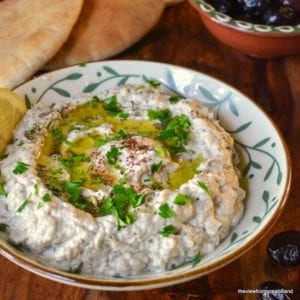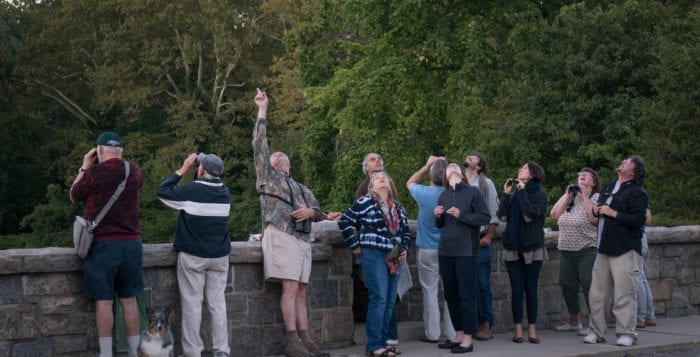By Barbara Beltrami
Actually, eggplant comes in many more shapes and sizes than the large purple global variety with which we are all familiar. A member of the nightshade family, its flowers, not the eggplant itself, can be female or male. So the preference for one or the other is based on myth. What you should concentrate on when choosing an eggplant is the skin, the weight and the hardness or softness of it. A fresh, ripe eggplant has glossy, taut skin, feels somewhat heavy and can be depressed with the thumb with just a little resistance and then return to its form.
While most people think of eggplant as one of the basic ingredients in the popular Italian American dish, eggplant parmigiana, it is, in fact, a staple of many diets, particularly in the Near and Far East. From the Syrian baba ghanoush to the Indian bhurtha to the Thai pud makua yow, eggplant crosses most ethnic boundaries to remind us that we’re not very much different from one another. I don’t often feature Asian recipes in this column simply because I have little experience with them. However, research among some acquaintances for whom the following recipes are traditional has expanded my repertoire.
Bhurtha

YIELD: Makes 4 servings
INGREDIENTS:
1 medium eggplant
3 tablespoons vegetable oil
1 medium onion, chopped
1 teaspoon grated fresh ginger
1 large tomato, diced
1 clove garlic, minced
1 teaspoon ground cumin
½ teaspoon turmeric
½ teaspoon ground coriander
¼ teaspoon cayenne pepper
Salt and freshly ground black pepper
1 handful fresh cilantro, chopped
DIRECTIONS: Preheat broiler. Rub eggplant skin with oil. Place under broiler and turn frequently until skin is charred and inside pulp is soft and mushy. Cut eggplant in half, scoop out flesh, cut into cubes and set aside. In a medium-large skillet, heat the oil, then add the onion, ginger, tomato, garlic, cumin, turmeric, coriander, cayenne, salt and pepper. Cook over medium heat, stirring frequently, just until onion turns opaque. Add eggplant and cook another 10 to 15 minutes, stirring frequently, until most of the moisture is evaporated. Transfer to serving dish and sprinkle with cilantro. Serve with naan (oven-baked flatbread), jasmine rice and peas.
Baba Ghanoush

YIELD: Makes 6 to 8 servings
INGREDIENTS:
2 large eggplants
Juice of 2 lemons
2 tablespoons tahini
One large clove garlic, finely minced
Coarse salt, to taste
¹/3 cup chopped flat-leaf parsley
3 tablespoons extra virgin olive oil
DIRECTIONS: Wash eggplants and grill whole on gas grill over medium-low heat. Turn frequently until eggplant is cooked on all sides, skin is charred and pulp is soft. Remove from heat, place on a platter and let cool for one hour. Do not be alarmed if it collapses. Peel the eggplant, scrape any flesh that adheres to the skin and put that plus the remaining flesh into a bowl; immediately add lemon juice and mash it in with the eggplant. Add tahini, garlic and salt and mix well. Cover tightly with plastic wrap and chill. Transfer mixture to a shallow bowl, sprinkle with parsley, and drizzle with olive oil. Serve with pita bread and black olives.
Pud Makua Yow

YIELD: Makes 4 servings
INGREDIENTS:
2 tablespoons vegetable oil
2 garlic cloves, minced
2 serrano chiles, stemmed and minced
2 to 3 medium eggplants (preferably the long Japanese ones), cut into one-inch cubes
1 cup water
2 to 3 tablespoons soy sauce
1 tablespoon fish sauce
1½ cups Thai sweet basil leaves, packed
DIRECTIONS: Pour oil into a wok or large skillet; add garlic and chiles. Over medium heat, cook, stirring constantly, until garlic releases its aroma. Add eggplant and one cup water; stir, cover and cook, stirring occasionally and adding more water if necessary, until eggplant is tender, about 5 to 10 minutes. If too much liquid remains, uncover and continue cooking until it is evaporated. Add soy and fish sauces and stir; then add basil and stir again. Serve immediately with rice, tofu or chicken.




 Local retail community partners will offer special events throughout the month to benefit the Fund for the Uninsured including:
Local retail community partners will offer special events throughout the month to benefit the Fund for the Uninsured including:



 MEET OLAF! This handsome boy is Olaf, a two-year-old medium-haired orange tabby who is currently waiting for his furever home at Kent Animal Shelter. Olaf loves to snuggle and is super mushy. He comes neutered, microchipped and up to date on all his vaccines. Won’t you stop by and say hello? Kent Animal Shelter is located at 2259 River Road in Calverton. For more information on Olaf and other adoptable pets at Kent, please call 631-727-5731 or visit www.kentanimalshelter.com.
MEET OLAF! This handsome boy is Olaf, a two-year-old medium-haired orange tabby who is currently waiting for his furever home at Kent Animal Shelter. Olaf loves to snuggle and is super mushy. He comes neutered, microchipped and up to date on all his vaccines. Won’t you stop by and say hello? Kent Animal Shelter is located at 2259 River Road in Calverton. For more information on Olaf and other adoptable pets at Kent, please call 631-727-5731 or visit www.kentanimalshelter.com.













